| Srl | Item |
| 1 |
ID:
179647
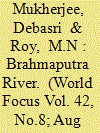

|
|
|
|
|
| Summary/Abstract |
‘Yarlung Zangbo’ or ‘Brahmaputra River’ is considering one of the youngest rivers in the world travelling nearly 2840 km from Tibet Himalayan range and crossing important international borders of China & India and finally merges with Bay of Bengal in Bangladesh.
|
|
|
|
|
|
|
|
|
|
|
|
|
|
|
|
| 2 |
ID:
125973
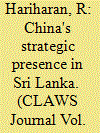

|
|
|
| 3 |
ID:
131226


|
|
|
| 4 |
ID:
127771
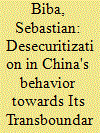

|
|
|
|
|
| Publication |
2014.
|
| Summary/Abstract |
Fresh water has no substitute, and its availability has been declining sharply around the globe. In Asia, China's role as a multidirectional and transborder water provider is unmatched. Analysis of China's behavior towards its transboundary rivers is therefore pivotal. By examining three different case studies-the Mekong River in Southeast Asia, the Brahmaputra River in South Asia and the Irtysh and Ili Rivers in Central Asia-this article seeks to lay the theoretical groundwork for understanding China's behavior. It pits previously applied realist rationales against the more recent notion of desecuritization strategies and makes a case for the latter. While desecuritization implies non- or de-escalation, it does not necessarily mean genuine long-term cooperation. The future of Asia's shared waters may thus be a contentious one.
|
|
|
|
|
|
|
|
|
|
|
|
|
|
|
|
| 5 |
ID:
185773
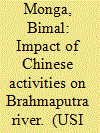

|
|
|
|
|
| Summary/Abstract |
The long-term plans of China for securing natural resources, including water, hold ominous portents for the world at large, and for its neighbouring countries in particular. As far as the trans-border water resources between India and China go, China has an advantage being the upper riparian state. Its plan to dam the Brahmaputra River has particularly rung alarm bells in India. The potential impact of dams, not only on the livelihood and sustenance of the population dependent on the waters of the Brahmaputra River but also on their very existence due to catastrophic earthquakes and floods, is worrisome. Moreover, China’s capability and, arguably, the intent to use water as a weapon, when required, is another aspect India has to be mindful of. It is, therefore, imperative for India to evolve a well ‘thought-out’ and ‘thought-through’ strategy in concert with other lower riparian and like-minded states and international organisations to ensure that its security interests are safeguarded.
|
|
|
|
|
|
|
|
|
|
|
|
|
|
|
|
| 6 |
ID:
127770
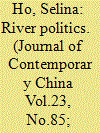

|
|
|
|
|
| Publication |
2014.
|
| Summary/Abstract |
China manages its transboundary rivers as a subset of its broader relations with other riparian states. This results in discernible differences in the way China approaches its international river systems. Although there is a limit to the extent of Chinese cooperation, in relative terms China is more cooperative in the Mekong than in the Brahmaputra. To China, Southeast Asian states are part of a hierarchical system where it stands at the apex. While problems exist, there are deep linkages between them, which help foster collaboration in the Mekong. India, which has greater power parity with China, is not part of China's hierarchical worldview. The territorial disputes and security dilemmas that characterize South Asian geopolitics further impede cooperation. Domestic considerations also impact on China's river policies. There is greater consensus among Chinese policymakers in managing the Mekong than the Brahmaputra, which explains the higher degree of clarity in Chinese policies towards the former compared to the latter.
|
|
|
|
|
|
|
|
|
|
|
|
|
|
|
|
| 7 |
ID:
161119
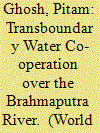

|
|
|
|
|
| Summary/Abstract |
Water related conflicts have a long history and will continue to be a global and regional problem. As water scarcity in both China and India worsens with rapid economic development and population expansion, the competition over shared water resources in Transboundary Rivers, particularly the Brahmaputra will intensify.
|
|
|
|
|
|
|
|
|
|
|
|
|
|
|
|
| 8 |
ID:
142241
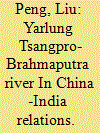

|
|
|